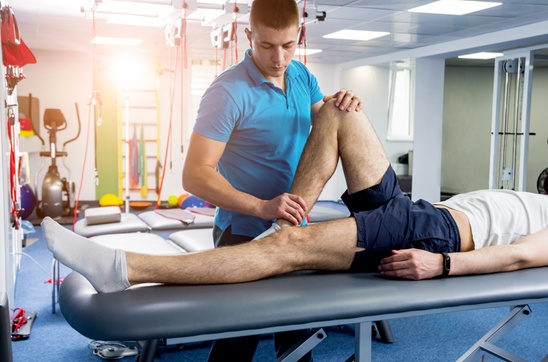Physical therapy plays a crucial role in the recovery process following sports injury surgery. Its primary goals are to restore function, improve mobility, strengthen muscles, reduce pain, and prevent further injury.
Here’s how physical therapy contributes to each stage of recovery:
Initial Post-Surgery Phase
Pain Management and Swelling Reduction:
- Techniques: Use of ice, compression, elevation, and electrical stimulation.
- Education: Guidance on managing pain and swelling at home.
Range of Motion (ROM) Exercises:
- Gentle Movements: Start with passive ROM exercises to prevent stiffness.
- Gradual Increase: Progress to active ROM exercises as tolerated.
Protection of Surgical Site:
- Instruction: Education on protecting the surgical site while performing daily activities.
- Use of Assistive Devices: Crutches, braces, or slings to support healing.
Intermediate Phase
Strengthening Exercises:
- Isometric Exercises: Begin with isometric exercises to strengthen muscles without joint movement.
- Progressive Resistance: Gradually incorporate resistance training using bands, weights, or body weight.
Balance and Proprioception Training:
- Stability Exercises: Use balance boards, stability balls, and single-leg stands to improve proprioception.
- Coordination Drills: Implement coordination drills to enhance neuromuscular control.
Functional Training:
- Task-Specific Exercises: Incorporate exercises that mimic specific sports movements.
- Activity Simulation: Gradually reintroduce movements related to the sport, such as running or jumping.
Advanced Phase
Advanced Strength and Conditioning:
- Sport-Specific Conditioning: Focus on advanced strength training and conditioning tailored to the athlete’s sport.
- Plyometric Exercises: Integrate plyometrics to improve power and explosiveness.
Agility and Speed Training:
- Agility Drills: Use ladder drills, cone drills, and other agility exercises to improve quickness and direction changes.
- Speed Work: Implement sprinting and acceleration exercises.
Endurance Training:
- Cardiovascular Exercises: Include running, cycling, or swimming to improve overall endurance.
- Sport-Specific Endurance: Conduct drills that replicate the duration and intensity of the sport.
Return to Sport Phase
Gradual Return to Play:
- Monitoring: Carefully monitor the athlete’s response to increasing activity levels.
- Progression: Gradually reintroduce sport-specific skills and drills.
Injury Prevention:
- Education: Teach proper techniques and body mechanics to prevent re-injury.
- Maintenance Program: Develop a long-term conditioning and flexibility program to maintain gains and prevent future injuries.
Psychological Support:
- Mental Conditioning: Provide mental strategies to cope with the stress of returning to sport.
- Confidence Building: Use positive reinforcement and gradual exposure to build confidence in the athlete’s ability to perform.
Continuous Assessment and Adjustment
Regular Evaluations:
- Progress Tracking: Regularly assess progress and adjust the therapy program as needed.
- Addressing Setbacks: Quickly identify and address any setbacks or complications.
Communication:
- Team Collaboration: Maintain open communication with the surgeon, coaches, and other healthcare professionals to ensure a cohesive recovery plan.
- Feedback Loop: Incorporate feedback from the athlete to tailor the program to their needs and comfort level.
By following a structured physical therapy program tailored to the individual’s needs and the specifics of their surgery, athletes can optimize their recovery, reduce the risk of re-injury, and effectively return to their sport.





Comments